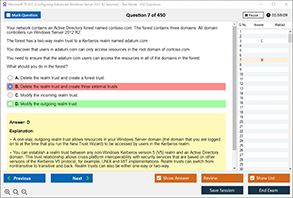Introduction to the CompTIA SY0-701 Exam
The cybersecurity landscape is constantly evolving, and IT professionals must stay updated with the latest knowledge and certifications to protect their networks and systems. The CompTIA Security+ SY0-701 exam is a globally recognized certification that validates foundational security skills, making it an essential credential for aspiring cybersecurity professionals. This exam assesses one's ability to identify, mitigate, and respond to security threats, including vulnerabilities and exploits.
This blog will explore key aspects of the CompTIA SY0-701 exam, focusing on vulnerabilities and exploits two crucial concepts every cybersecurity professional must understand. We will define these terms, explain their differences, discuss their significance in the exam, and provide insights on mitigating them effectively.
Definition of the CompTIA SY0-701 Exam
The CompTIA Security+ SY0-701 exam is designed to certify IT professionals with core cybersecurity skills. It is an entry-level certification but holds significant value in the industry. The exam covers a broad range of topics, including:
- Threats, Attacks, and Vulnerabilities
- Security Architecture and Design
- Security Operations
- Incident Response
- Governance, Risk, and Compliance
The exam is suitable for professionals seeking roles such as security administrator, systems administrator, security consultant, and network administrator. It provides a strong foundation for further cybersecurity certifications and career growth.
Key Differences Between a Vulnerability and an Exploit
Understanding the distinction between vulnerabilities and exploits is critical for the CompTIA SY0-701 exam and real-world cybersecurity applications.
What is a Vulnerability?
A vulnerability is a weakness in a system, application, or network that attackers can exploit to gain unauthorized access or cause harm. Vulnerabilities may arise due to poor coding, misconfigurations, outdated software, or weak security policies. Examples include:
- Unpatched software: Failing to update applications leaves security gaps open.
- Weak passwords: Easily guessable credentials make systems susceptible to brute-force attacks.
- SQL injection flaws: Poorly coded databases can be manipulated to access unauthorized information.
What is an Exploit?
An exploit is an actual attack or method used to take advantage of a vulnerability. While vulnerabilities are weaknesses, exploits are active tools or techniques hackers use to breach security. Exploits can be automated scripts, malware, or phishing attacks designed to leverage vulnerabilities. Common exploit types include:
- Zero-day exploits: Attacks that occur before a vulnerability is patched.
- Remote code execution (RCE): Attackers remotely execute malicious code on a system.
- Privilege escalation: Gaining higher access privileges through security loopholes.
Key Differences
|
Aspect |
Vulnerability |
Exploit |
|
Definition |
A weakness in a system |
A method used to take advantage of a weakness |
|
Passive or Active? |
Passive (exists within a system) |
Active (requires an attacker to act) |
|
Examples |
Unpatched software, weak passwords |
Malware, phishing attacks, zero-day threats |
Importance of Understanding Vulnerabilities and Exploits for the CompTIA SY0-701 Exam
The CompTIA SY0-701 exam heavily focuses on cybersecurity threats and defense mechanisms. Understanding vulnerabilities and exploits is vital because:
- Real-World Application: Security professionals must identify and remediate vulnerabilities before they become entry points for attacks.
- Risk Management: Recognizing vulnerabilities helps organizations prioritize risk and implement effective security controls.
- Exam Relevance: Many exam questions assess the ability to detect, analyze, and mitigate security threats.
- Incident Response: In security operations, knowing how to respond to an exploit can prevent data breaches and financial loss.
For exam success, candidates must understand how vulnerabilities arise, how exploits target them, and how to mitigate risks effectively.
How to Mitigate Vulnerabilities and Exploits
Mitigating vulnerabilities and exploits is a fundamental skill for cybersecurity professionals. The CompTIA SY0-701 exam covers several best practices for securing systems against threats:
1. Regular Software Patching and Updates
Keeping software and systems updated is crucial. Patching vulnerabilities prevents attackers from exploiting known weaknesses. Organizations should:
- Enable automatic updates for critical software.
- Apply security patches as soon as vendors release them.
- Use a vulnerability management system to track and fix issues.
2. Implementing Strong Authentication Mechanisms
Weak passwords and insecure authentication methods are common vulnerabilities. Secure authentication practices include:
- Using multi-factor authentication (MFA).
- Enforcing complex password policies.
- Implementing biometric authentication where applicable.
3. Network Security Measures
A well-secured network prevents unauthorized access and data breaches. Effective strategies include:
- Firewalls: Preventing unauthorized traffic.
- Intrusion Detection Systems (IDS): Monitoring for suspicious activity.
- Virtual Private Networks (VPNs): Encrypting remote access.
4. Conducting Security Awareness Training
Human error is one of the biggest security risks. Organizations should educate employees about:
- Phishing attacks and how to recognize suspicious emails.
- Safe browsing habits to avoid malware infections.
- Incident reporting procedures to ensure timely action.
5. Performing Regular Security Audits and Penetration Testing
Proactively testing security controls helps identify and fix vulnerabilities before attackers exploit them.
- Vulnerability assessments: Scanning systems for weaknesses.
- Penetration testing: Simulating real-world attacks to test defenses.
- Log monitoring: Detecting unusual activity in real-time.
6. Data Encryption and Backup Strategies
Encrypting sensitive data protects it from unauthorized access. Regular backups ensure data recovery in case of an attack.
- Full-disk encryption for devices.
- End-to-end encryption for communications.
- Offsite and cloud backups for data redundancy.
Conclusion
The CompTIA Security+ SY0-701 exam is an essential certification for anyone pursuing a career in cybersecurity. A key component of the exam is understanding vulnerabilities and exploits, as well as how to mitigate security risks effectively.
By learning about different types of vulnerabilities and exploits, candidates can enhance their ability to identify threats, strengthen security measures, and respond to incidents efficiently. Mitigation strategies such as patch management, strong authentication, network security, security training, and penetration testing play a vital role in securing systems against cyber threats.
For IT professionals preparing for the SY0-701 exam, mastering these concepts is crucial for both passing the exam and excelling in real-world cybersecurity roles. By leveraging reliable study materials, practice tests, and hands-on experience, candidates can confidently earn their CompTIA Security+ certification and advance in the cybersecurity field.
For the latest CompTIA SY0-701 study guides, practice tests, and exam resources, visit DumpsBoss your trusted partner in IT certification success!
Special Discount: Offer Valid For Limited Time “SY0-701 Exam” Order Now!
Sample Questions for CompTIA SY0-701 Dumps
Actual exam question from CompTIA SY0-701 Exam.
What is the difference between a vulnerability and an exploit?
A. A vulnerability is a weakness in a system, while an exploit is a method used to take advantage of that weakness.
B. A vulnerability is an attack, and an exploit is the system's defense mechanism.
C. A vulnerability and an exploit are the same things.
D. An exploit is a potential risk, while a vulnerability is an actual attack.


